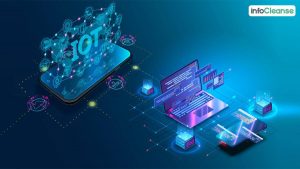
From the 80s to throughout the 90s, when people began experimenting with the thought of adding sensors along with intelligence to objects, no one could’ve guessed the impact IoT would go on to have on the future.
Whether it’s Artificial intelligence, supply chain management, or healthcare center – today, people can’t stop talking about IoT implementation in various businesses. It has truly become a bridge that connects our digital & physical universes.
According to 2019 estimates from Mordor Intelligence, the IoT market is currently expected to reach $6.1 billion in value by 2024 along with a CAGR of 31.8%. This clearly indicates how the global market highly favors IoT development.
What makes IoT even better is the potential it carries to perform much faster and one such component for growth is through data analytics. IoT and Data, no doubt, remain intrinsically linked.
If you have already become familiarized with IoT (Internet of Things) connected devices, you may be aware of how their relevancy and existence largely rely on the data they obtain.
But, the thing is, for the end-user, the raw data is not something they find valuable, instead, it is the digestible explanation found in the gathered information (i.e. data analytics).
As data achieved from IoT devices is deemed valuable for marketing if it is only subjected to analysis, this brings data analytics into the frame.
By definition, Data Analytics or DA is a process used in examining both big & small datasets with data properties that are varying in nature for extracting meaningful conclusions along with actionable insights.
These conclusions typically exist in the form of patterns, trends, and statistics that assist business organizations in engaging proactively with data for implementing efficient decision-making processes.
What attracts consumers to an IoT solution is its ability to offer data in an absorbable and meaningful way. Anyone can print and hand off data sets, however, it requires time and effort from the user’s end to manually analyze that information and carve it into something workable.
Data analytics enables users to pick up the trends or patterns within the information gathered by their device with ease. Through the insight DA provides, it makes sure users are equipped with the right knowledge to confidently navigate an effective business/personal product decision.
Regarding IoT technology, consumers are more than prepared to invest upfront due to the probability of the solution paying for itself after some time. This is possible by pinpointing those areas with wasted resources or saving time & effort through task automation.
Once again, powerful & intelligent data analytics maintain a key role by providing them those metrics that are integral in making these realizations come true. In this, individuals and businesses carry significant power as they can be picky regarding data quality.
As IoT integration becomes much more present in our daily activities and life, DA remains imperative in assisting users to draw key insights.
Data analytics can play a significant role in the growth & success of IoT applications and/or investments. Here’s how analytics tools can allow businesses to create an effective use for their datasets:
Data analytics come in different types to be utilized and applied in IoT investments for gaining advantages. Some of these include:
This is a form of DA that is also referred to as event-stream processing. What it does is analyze large in-motion datasets and during this process, data streams in real-time are analyzed for detecting urgent situations along with immediate actions.
IoT applications that are based on air fleet tracking, financial transactions, traffic analysis and more can all benefit through this method.
This is a DA method that’s utilized for analyzing geographic patterns for determining the spatial relationship that exists between physical objects. IoT applications that are location-based can benefit greatly through this method of data analytics. For instance, smart parking applications.
As suggested by its name, time-series analytics is another form of DA that is established upon time-based data and it is analyzed for revealing associated trends & patterns. The IoT applications that can largely benefit from this method are health monitoring systems along with weather forecasting applications.
This is a combined form of DA deriving from a combination of descriptive & predictive analysis. It is often applied for understanding the best actionable steps that can or should be taken during a specific situation.
With this type of data analytics, commercial IoT applications are more likely to gain and utilize it for drawing better conclusions.
Advanced data analytics no longer remains a fancy add-on, instead, it proves to be quite integral in any IoT solution as it provides users with enough knowledge for making smarter decisions and pointing out certain issues.
It is safe to say, IoT is sustained through the capability & power of data. Despite how valuable pure quantitative data may be, there’s far more power involved in how data is categorized and the type of insights users can draw from it.
Organizations or businesses wish to retain their employees for longer periods of time to witness…
To halt the march of global warming and achieve the temperature target set by the…
B2B sales lead generation is a highly challenging task, and for marketers seeking an easy…
Marketing in the healthcare industry is a daunting task. It puts an immense sense of…
Metaverse has made its entry into our day-to-day parleys. An inevitable innovation of the internet,…
In an era of knowledge-driven economics, information is an asset. An enterprise’s extent of success…